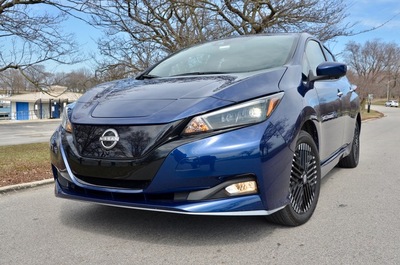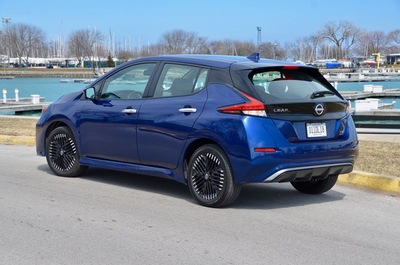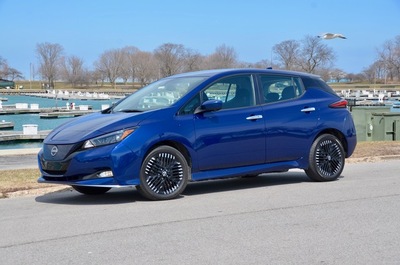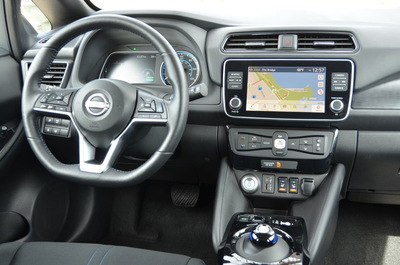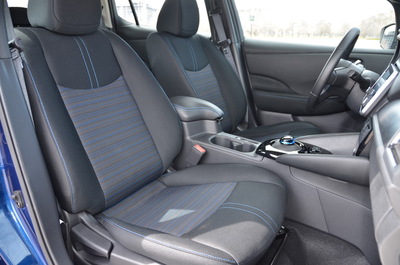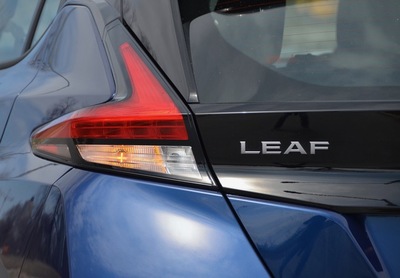2023 Nissan LEAF Rational Mobility, Review By Larry Nutson
2023 Nissan LEAF
Rational Mobility
By Larry Nutson
Executive Editor and Bureau Chief
Chicago Bureau
THE AUTO CHANNEL
Is it range anxiety or charging anxiety?
In a survey of 4,410 people nationwide Reuters/Ipsos asked whether they’d consider buying an all-electric vehicle as their next vehicle. Despite most Americans driving just 30 to 40 miles a day, the survey showed that a third of U.S. consumers who would consider buying an all-electric vehicle as their next vehicle say they need at least 500 miles of charge – with another third saying they need at least 300 miles.
The desire for your car to have a range far beyond what you use in daily life – dubbed “range anxiety” in the industry – is the paradox of the electric age. In part, you could argue range anxiety is a result of charging anxiety – people don’t trust that they’ll find a charging point when they need it and would rather be safe.
There are over 40 electric vehicles on the market today. I just drove one of them; the 2023 Nissan LEAF. LEAF is offered in two trim levels or grades; the LEAF S and the LEAF SV PLUS.
LEAF S is equipped with a 40-kWh lithium-ion battery and 110-kW electric motor that delivers 147 horsepower, 236 lb-ft of torque and has an EPA-estimated 149 miles of range. LEAF SV PLUS features a larger-capacity 60-kWh lithium-ion battery – increasing the range to an EPA-estimated 212 miles and a powerful 160-kW electric motor that produces 214 horsepower and 250 lb-ft of torque. Both the S and SV Plus are front-wheel drive.
The average EPA-estimated driving range of 2023 model EVs is around 260 miles. I see the LEAF as being well suited to fill the role of the secondary or commuter car in a household fleet. And this is perhaps its strongest use case. The S with 149 miles might be a bit short for some. The SV Plus with its 212 miles is a better choice. However, your needs for your typical driving pattern must be considered in determining if a BEV is right for you.
Just like a gasoline powered vehicle where you can’t run the fuel tank dry, you can’t run a battery down completely. At 10% remaining charge in the battery it’s time to recharge to best maintain long battery life.
Charging convenience is all important. Personally, I recommend the installation of a Level 2 charger at your residence. It’s key to a good ownership experience. If you live in a cold climate it is best to be able to garage a BEV and plug it in overnight. Driving range drops off in colder temps, especially below freezing temps.
The LEAF S can be charged up to 80 percent in 40 minutes, while the LEAF SV PLUS can be charged up to 80 percent in 60 minutes using the quick charge port. Also standard is a portable charging cable that can be plugged into either a 120-volt outlet or any 240-volt outlet, such as those used for electric clothes driers. But take note, charging times get longer at cold ambient temperatures.
The compact 4-door hatchback LEAF, which has been around since 2010, has been refreshed for 2023. Up front there’s a new grille shape and front bumper molding. Headlight styling has also been revised and SV PLUS models feature a new 5-spoke 17-inch aluminum-alloy wheel design. There are also some changes to the wind deflectors and exterior badging has been updated.
Inside, changes for the 2023 model year include a new brand identity badge on the steering wheel and a new start-up video on the instrument panel screen. Black cloth is standard on both trims, with gray finishers for LEAF S and gloss black finishers for LEAF SV Plus.
The LEAF is equipped with a long list of collision warning, collision intervention, and driving control assistance features, including Nissan’s ProPilot Assist hands-on driver assist system on the LEAF SV Plus.
Every 2023 Nissan LEAF is offered with a limited lithium-ion battery warranty covering defects in materials or workmanship for eight years or 100,000 miles, whichever comes first, for the battery pack. Visit www.NissanUSA.com for more information.
With a 106.3 inch wheelbase and an overall length of 176.4 inches, the LEAF is well suited for the urban landscape…not too big and not too small. Dynamically the LEAF is comfortable to drive with a good ride and decent handling. Electric motors develop instantaneous torque providing quick acceleration. Estimates for 0-60 acceleration time are in the low seven second range. This is plenty quick for the average driver.
As with many other new vehicles, supply has tamped down sales. Nissan informs inventory is starting to grow and demand remains strong as the LEAF is one of the most affordable all-electric vehicles in the marketplace. The 2023 LEAF received KBB’s lowest 5-Year Cost To Own among EVs for five years in a row now, making it an even more desirable option.
The 2023 LEAF S is priced at $28,040. LEAF SV Plus is $36,040. Plus, the destination and handling charge is $1,095.
Electric vehicles now cost an average of more than $58,000, according to KBB. That’s a price beyond the reach of many U.S. households. The LEAF offers very good value in comparison and is more affordable than most other EVs.
The Auto Channel includes FuelEconomy.gov on its review page to help consumers cash in on new federal tax credits for clean vehicle purchases. The Inflation Reduction Act (IRA) provides new opportunities for consumers to save money on clean vehicles. FuelEconomy.gov has developed a new tool through the Tax Center to help consumers shop for clean vehicles eligible for these tax credits and help car buyers navigate the requirements. The website provides a simple calculator to help buyers determine the credit for pre-owned vehicles, provides information on claiming each of the credits, and answers frequently asked consumer questions. Visit the FuelEconomy.gov Tax Incentives page.
The future is electric. Happy motoring!
© 2023 Larry Nutson, the Chicago Car Guy
2023 Nissan LEAF features revised exterior, new wheels and streamlined model lineup
The all-electric Nissan LEAF continues to play a key role in Nissan's accelerating shift to electrification with a refreshed exterior treatment and new aluminum-alloy wheels for the 2023 model year.
On sale now, the 2023 LEAF will be available in two grade levels, the LEAF S and the LEAF SV PLUS. The streamlined model lineup reflects a consolidation of the most requested features and technologies.
The 2023 LEAF
The updates to the 2023 LEAF start with a revised front end appearance, including a new grille shape and front bumper molding. Headlight styling has also been revised with a new black inner finisher (previously chrome) and SV PLUS models feature an aggressive new 5-spoke 17-inch aluminum-alloy wheel design.
Both front and rear fascia wind deflectors are now black (previously blue) and the shapes of the tire deflectors at all four corners, rear under diffuser and rear spoiler have all been modified. In addition, exterior badges have been updated to reflect the new Nissan brand identity.
All of these enhancements enhance LEAF's distinctive appearance, with a sleek, streamlined, sporty silhouette.
The 2023 LEAF is available in seven body colors. Brilliant Silver Metallic, Gun Metallic, Super Black and Deep Blue Pearl are offered on both S and SV PLUS, while Glacier White is available on LEAF S only. Colors exclusive to LEAF SV PLUS are Scarlet Ember Tintcoat (premium color), Pearl White Tricoat (premium color), and one two-tone exterior paint treatment: Pearl White Tricoat/Super Black (premium color).
Inside, changes for the 2023 model year include a new brand identity badge on the steering wheel and a new start-up video on the instrument panel screen. Black cloth is standard on both trims, with gray finishers for LEAF S and gloss black finishers for LEAF SV Plus.
The 2023 LEAF's roomy cabin comfortably accommodates five people and includes a 60/40 split fold-down rear seat for added flexibility. The rear cargo area is designed to provide ample luggage space, offering 30 cubic feet of available storage with the second row folded down.
Large display and more technology
Every 2023 Nissan LEAF features a full-color 8-inch display. Advanced technologies include standard Apple CarPlay® and Android Auto™. LEAF SV PLUS includes Nissan Door to Door Navigation, and NissanConnect EV and services (telematics), which allows a remote connection to the vehicle to start a charge, monitor the state of a charge and turn on the heat or A/C before ever getting into the vehicle.
The LEAF SV PLUS's standard Door-to-Door Navigation system syncs the vehicle's navigation system with a compatible smartphone for seamless driving and walking directions. The connections feature allows any of the car's passengers to quickly and easily connect to a device within the vehicle.
Choice of two powertrains
The 2023 LEAF S is equipped with a 40-kWh lithium-ion battery and 110-kW electric motor that delivers 147 horsepower, 236 lb-ft of torque and up to 149 miles1 of range.
The 2023 Nissan LEAF SV PLUS features a larger-capacity 60-kWh lithium-ion battery – increasing the range to up to 212 miles2 and a powerful 160-kW electric motor that produces 214 horsepower and 250 lb-ft of torque.
Every 2023 Nissan LEAF is offered with a limited lithium-ion battery warranty covering defects in materials or workmanship for eight years or 100,000 miles, whichever comes first, for the battery pack. Nissan also provides a limited warranty against battery capacity loss below nine bars of capacity as shown on the vehicle's battery capacity level gauge for the first eight years or 100,000 miles for all models.3
Using the Quick Charge Port, the LEAF S can be charged7 up to 80 percent in 40 minutes, while the LEAF SV PLUS can be charged up to 80 percent in 60 minutes using the quick charge port. Also standard is a portable charging cable that can be plugged into either a 120-volt outlet or any 240-volt outlet, such as those used for electric clothes driers. The angle of the charging port at the front is designed for convenience, letting the customer connect the charging cable without bending down.
ProPILOT Assist and e-Pedal
Standard on the LEAF SV PLUS is ProPILOT Assist4, a hands-on driver assist system that combines Nissan's Intelligent Cruise Control and steering assist technologies and includes a stop and hold function that can bring the vehicle to a full stop, hold in place and can bring the vehicle back up to speed when traffic starts moving again.
Further enhancing the Nissan LEAF S and SV PLUS driving experience is the standard e-Pedal5, which allows the driver to start, accelerate, decelerate and come to a full stop and hold using only the accelerator pedal.
Along with e-Pedal, the 2023 LEAF is equipped with a range of standard driver assist technologies, including the six technologies that comprise Nissan Safety Shield® 360 - Automatic Emergency Braking with Pedestrian Detection, Lane Departure Warning, radar-based Blind Spot Warning, Rear Cross Traffic Alert, High Beam Assist and Rear Automatic Braking.
Other technologies include standard Intelligent Forward Collision Warning, Intelligent Lane Intervention and Blind Spot Intervention. Standard SV PLUS features include Intelligent Driver Alertness and Intelligent Around View® Monitor.
A pair of well-equipped models
Standard LEAF S grade equipment includes Nissan Safety Shield® 360 technology, Apple CarPlay® and Android Auto™, 8.0-inch information display, Rear Door Alert6, a system that can help remind customers of items that may be forgotten in the rear seat, automatic on/off headlights, Bluetooth® hands-free phone system, Bluetooth® streaming audio, SiriusXM® Radio (SiriusXM® subscription required, sold separately), automatic temperature control, 60/40 split fold-down rear seat and a Quick Charge Port.
Along with the more powerful motor and larger battery, the LEAF SV PLUS adds a higher output Quick Charge Port (100kW), ProPILOT Assist, steering assist, Intelligent Cruise Control with Full Speed Range and Hold, electric parking brake, 8-way power driver's seat with 2-way lumbar, auto-dimming inside mirror, LED headlights and LED Signature Daytime Running Lights, Intelligent Around View® Monitor, and Intelligent Driver Alertness.
Additional LEAF SV PLUS content includes new 17-inch aluminum-alloy wheels with 215/50R17 Michelin Energy Saver tires, fog lights, leather-wrapped steering wheel, Nissan Door to Door Navigation, SiriusXM® Traffic and SiriusXM® Travel Link (SiriusXM® subscription required, sold separately), NissanConnect® EV & Services powered by SiriusXM®, 6-speaker audio, heated front seats and steering wheel, heated outside mirrors and hybrid heater.
Just one option is available for the SV PLUS, a cargo area cover.
- EPA range for MY23 Nissan LEAF S (40kW) up to 149 miles. Actual range may vary based on driving conditions.
- EPA range up to 212 miles for MY23 Nissan LEAF SV PLUS. Actual range may vary based on driving conditions.
- For complete information concerning coverage, conditions and exclusions, read the actual New Vehicle Limited Warranty booklet at a Nissan dealership or at www.nissanusa.com/owners/vehicle-resources/manuals-guides.html.
- ProPILOT Assist cannot prevent collisions. It is the driver's responsibility to be in control of the vehicle at all times. Always monitor traffic conditions and keep both hands on the steering wheel. System operates only when lane markings are detected. Does not function in all weather, traffic and road conditions. System has limited control capability and the driver may need to steer, brake or accelerate at any time to maintain safety. See Owner's Manual for safety information.
- Monitor traffic conditions and use conventional brake as needed to prevent collisions. See Owner's Manual for safety information.
- Does not detect people or cargo. Always check rear seat before exiting.



